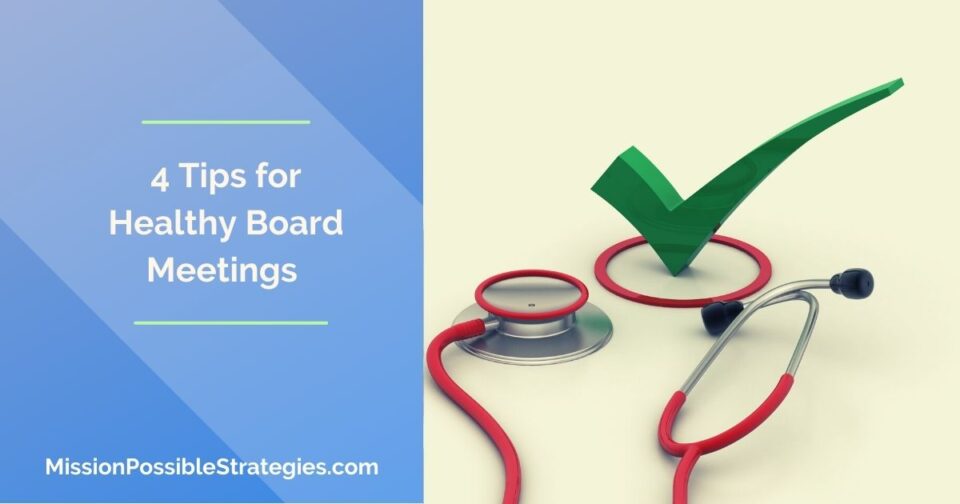This blog post explores the characteristics of a healthy nonprofit board and ways to conduct healthy board meetings.
I read a story about a consultant who gave a presentation at a conference of nonprofit executive directors and board members. He asked participants to turn to a neighbor and respond to the following:
Describe your board’s culture with the title of a movie, song or TV show.
Some of the answers included:
- He’s Just Not That Into You
- Titantic
- Grumpy Old Men
You have to wonder about what goes on at some of those board meetings!
I know from experience some obvious symptoms of unhealthy board meetings:
- The President must ask board members for their annual contribution at every meeting.
- More time is spent on the past than the future.
- There is low attendance.
- The meetings don’t start and end on time.
- One person dominates the conversation.
- And of course, snoring is an obvious sign!
But what makes a board healthy? How can you ensure healthy board meetings?
1. Healthy Boards are Emotionally Connected
Most nonprofit boards gather four or six times a year so board members never have the opportunity to socialize and become more deeply connected. They know one another’s names but the group hasn’t formed into a cohesive whole.
That’s a mistake. A crisis will come one day and it will be important that board members have built authentic, trusting relationships with one another. Board members need to transition from a group of strangers to a team of leaders.
Tip 1 > Try to squeeze in a little social time before or after board meetings. Make sure board members sit next to someone new at each board meeting by moving the nameplates around.
2. Healthy Boards are Mentally Focused
All too often, board members must sit through mind-numbing meetings with predetermined outcomes. These board meetings are boring.
When we offer board members “mind-numbing show-and-tell meetings,” how can we possibly expect them to be enthusiastic, generous, and engaged?
A mentally focused board is also a well-rounded group of leaders with a variety of backgrounds and skills. Board members engage in the challenging, big-picture issues that the organization is facing. Meetings are designed to tap into the wisdom and experience of board members so they can contribute to a vibrant discussion and well-informed decisions.
Tip 2 > Always have at least one agenda item that requires important strategic discussion and voting. Use a consent agenda that eliminates monotonous committee reports. (A consent agenda allows the board to approve committee reports and minutes without discussion or individual motions.)
3. Healthy Boards are Physically Energized
Some of the most memorable and impactful moments occur when board members are not sitting at the board table.
Rather, they are in break-out groups, spread across the room, with markers and whiteboards. Engage your board in new and different ways and incorporate movement into board service.
Here is a short simple game:
- Divide the group in half. Teams are standing in two lines facing each other.
- Each team organizes itself alphabetically by first name.
- The winning team is the one that is the quickest!
Keep the game going for as many categories as you like. Other suggestions for alphabetical groupings include birthplace and job title. Suggestions for numerical or chronological groupings: year of birth, height or the number of countries visited.
Tip 3 > Ask board members to take turns presenting an icebreaker that requires physical movement. For ideas, go to https://www.quizbreaker.com/icebreakers-for-adults.
4. Healthy Boards are Spiritually Aligned
Board service can easily become limited to a series of mundane board and committee meetings. Ensuring that board members stay spiritually aligned with the mission should be a priority.
Board members need to stay personally connected at a deep emotional level to the work of the organization. They need to stay connected to the cause that first stirred their passion and moved them to get involved.
That might mean walking the halls of the ward where kids are dealing with cancer. Or hearing the stories of healing directly from nurses and doctors. Time spent remembering “The Why” behind board service is priceless.
Tip 4 > Have the mission printed at the top of the agenda and always have a “Mission Moment” at each board meeting. (A “mission moment” is a tiny, powerful example of how your organization is making an impact. It MUST be an example of a real person.) Ask clients to attend board meetings or have a board meeting at a location where your services are offered.
Summary: Ask yourself these questions before your next board meeting:
- How can you build social time into the board’s activities so that meaningful relationships are formed?
- How might you restructure the agenda in a way that encourages directors to bring their A-game?
- What activity or experience might you use to get board members out of their seats?
- How might you bring board members back to the heart of the mission?
If you need help with your board culture or board meetings, you can book a 90-minute strategy session with me.
And Remember…You’re not alone. You can do this!
* Source: Robert Acton, Cause Strategy Partners


